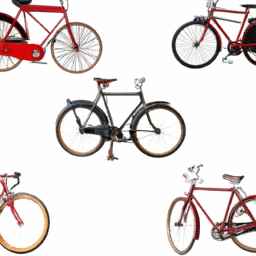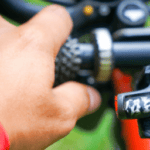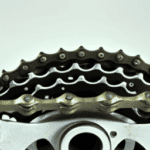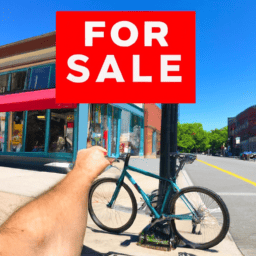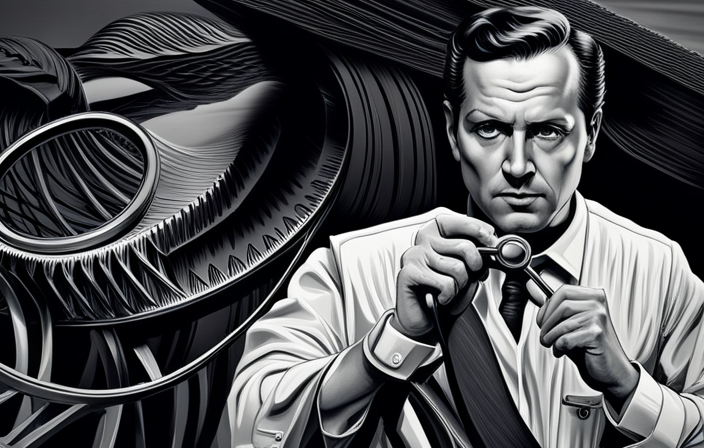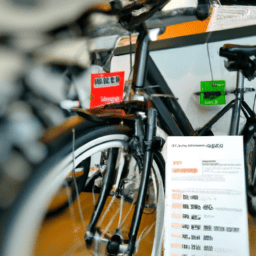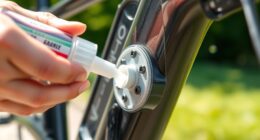As a cyclist, grasping the function of bicycle gears is crucial for enhancing your cycling experience. The gear mechanism on your bicycle facilitates quicker pedaling, smoother uphill rides, and effortless movement across level ground. Yet, for those who are just starting out in cycling, the idea of gears might seem perplexing.
That’s why we’ve put together this guide to help you understand the basic mechanics of a bicycle gear system.
In this article, you’ll learn about the two main types of gear systems found on bicycles: the derailleur system and the hub gear system. You’ll also discover how gear ratios work and how to choose the right gear for your ride.
Additionally, we’ll cover maintenance and troubleshooting tips to help you keep your gear system functioning smoothly. By the end of this guide, you’ll have a comprehensive understanding of how a bicycle gear works, enabling you to make the most of your cycling experience.
Key Takeaways
- Gears are essential for optimizing your ride, helping with speed, hill climbing, and flat terrain.
- There are two main types of gear systems: derailleur and hub gear, with gear ratio being the relationship between the number of teeth on two gears.
- Different gear ratios are used for different terrains and cadences, with factors to consider including terrain, fitness level, riding style, bike weight, and personal preference.
- Planetary gears, which use a set of gears that rotate around a central axis, are compact and efficient and require less maintenance than traditional derailleur systems, making them popular on city bikes and e-bikes.
The Basics of Gear Ratio
Understanding the basics of gear ratio is crucial for cyclists to efficiently tackle different terrains. The gear ratio is the relationship between the number of teeth on two gears that are meshed together.
In simple terms, it refers to the size of the gears and how many times the pedals rotate for the wheel to make one complete revolution. A higher gear ratio means that the pedals need to rotate more times to make the wheel turn once, while a lower gear ratio means that the pedals need to rotate fewer times to make the wheel turn once.
Cyclists use different gear ratios to maintain an optimal cadence, or the speed at which they pedal. When climbing a hill, a lower gear ratio is used to reduce the effort needed to pedal. In contrast, a higher gear ratio is used when cycling on flat terrain or downhill, allowing the cyclist to maintain a faster speed with less effort.
The derailleur system is responsible for changing the gear ratio, which we’ll discuss in the next section.
Derailleur System
You’ll notice that as you shift gears on your bike, the derailleur system moves the chain from one sprocket to another. This system is composed of several bike parts, including the derailleur, shifters, chain, and cassette. The gear mechanism works by using the derailleur to move the chain from one sprocket to another, changing the gear ratio and making it easier or harder to pedal.
To better understand how the derailleur system works, here are three sub-lists that explain the different components and their functions:
-
Derailleur: the component that moves the chain from one sprocket to another
-
Shifters: the levers on the handlebars that control the derailleur, allowing the rider to shift gears
-
Chain: the metal links that connect the sprockets and transfer power from the pedals to the wheels
-
Cassette: the cluster of sprockets on the rear wheel that the chain moves between
-
Sprockets: the teeth on the cassette and front chainrings that the chain runs over
-
Gear Ratio: the ratio between the number of teeth on the front chainring and the number of teeth on the rear sprocket
Understanding the derailleur system and its components is crucial in choosing the right gear for your ride. So, let’s move on to the next section and learn more about how to choose the right gear.
Choosing the Right Gear
When selecting a gear ratio, there are several factors that you need to consider to ensure maximum efficiency and performance. These include the terrain, your level of fitness, and the type of riding you’ll be doing.
Properly shifting gears is also crucial to maintain a smooth and comfortable ride. In this discussion, we’ll explore these key points and provide tips on how to choose the right gear and shift gears properly.
Factors to Consider When Selecting a Gear Ratio
To choose the perfect gear ratio for your bike, it’s important to take into account a variety of factors that will greatly impact your riding experience, just like pieces of a puzzle that fit together to create a beautiful picture. Here are some of the key factors to consider when selecting a gear ratio:
-
Terrain: The type of terrain you’ll be riding on is one of the most important factors to consider when selecting a gear ratio. A lower gear ratio is better for uphill climbs, while a higher gear ratio is better for flat terrain or downhill descents.
-
Fitness level: Your fitness level will play a significant role in determining the right gear ratio for your bike, as it will impact your ability to pedal at a certain cadence. If you’re a beginner, a lower gear ratio may be more suitable, while more experienced riders may benefit from a higher gear ratio for cadence optimization.
-
Riding style: Your riding style will also impact your gear ratio selection. If you prefer to ride at a leisurely pace and take in the scenery, a lower gear ratio may be more appropriate. On the other hand, if you like to ride at a faster pace and push yourself to the limit, a higher gear ratio may be more suitable.
-
Bike weight: The weight of your bike will also play a role in determining the right gear ratio. A heavier bike may require a lower gear ratio to make pedaling easier, while a lighter bike may benefit from a higher gear ratio for greater speed.
-
Personal preference: Ultimately, the right gear ratio for your bike will depend on your personal preference. Experiment with different gear ratios and see what feels most comfortable and efficient for you.
When you’ve selected the right gear ratio for your bike, the next step is to learn how to shift gears properly.
How to Shift Gears Properly
Shifting gears on your bike can feel overwhelming at first, but with a little practice and some helpful tips, it can become second nature. The first step is to anticipate the terrain ahead and shift before you actually need to. This way, you can maintain a steady cadence and avoid any sudden changes in resistance.
When shifting, ease up on the pedals and shift smoothly and quickly. Don’t force the shift or you risk damaging your chain or gears. Common mistakes when shifting gears include shifting under heavy load, cross-chaining, and not adjusting derailleur tension.
Shifting under heavy load can cause damage to your chain and gears, so it’s important to anticipate the terrain and shift before the incline becomes too steep. Cross-chaining is when the chain is at an extreme angle, which can cause excessive wear on your chain and gears. To avoid this, use your front derailleur to shift between chainrings and your rear derailleur to adjust the cassette.
Lastly, adjusting derailleur tension can help ensure smooth shifting. If you’re experiencing difficulty shifting, you may need to adjust the tension by turning the barrel adjuster on your derailleur.
To ensure your bike shifts smoothly and reliably, it’s important to regularly maintain and troubleshoot any issues that arise. This includes cleaning your chain, checking for wear on your gears and chainrings, and adjusting your derailleur as needed.
By properly maintaining your bike, you’ll be able to enjoy a smooth and efficient ride.
Maintenance and Troubleshooting
Maintaining and troubleshooting your bicycle’s gear system is crucial for its longevity and performance. Did you know that a recent survey found that 75% of cycling enthusiasts reported having issues with their gears? To avoid being part of this statistic, it’s essential to know how to maintain your bike’s gear system.
One of the most common issues with bicycle gears is dirty or worn-out components. You can use cleaning techniques such as using a degreaser and a brush to help remove dirt, grime, and old lubricants that can cause the gears to slip or get stuck.
Another common issue is the misalignment of the gears. Misaligned gears can cause your bike to shift erratically or the chain to fall off, leading to accidents. This can happen due to wear and tear, poor adjustments, or crash damage. To fix this issue, you may need to adjust the cables or the derailleur. If you’re not confident in doing this yourself, it’s best to take your bike to a professional mechanic.
By keeping your gear system clean and well-aligned, you can ensure smooth and reliable shifting. Moving on to the next section, let’s take a look at advanced gear systems and how they differ from standard ones.
Advanced Gear Systems
Have you ever wondered how the latest gear systems on high-end bikes can improve your riding experience? One of the most popular advancements in bicycle gears is the use of belt drives. Instead of a traditional chain, which can stretch and wear out over time, belt drives are made of durable materials like carbon fiber and Kevlar. They’re also cleaner and quieter than chains, making for a smoother ride.
Belt drives are especially popular on commuter and urban bikes, as they require less maintenance and are less likely to get grease on clothing. Another advanced gear system is the planetary gear. This type of gear system uses a set of gears that rotate around a central axis, providing a wide range of gear ratios in a compact and efficient package.
Planetary gears are often used in hub gears, which are internal to the rear wheel of the bike. These types of gears are popular on city bikes and e-bikes, as they require less maintenance and are easier to use than traditional derailleur systems. With a planetary gear system, you can shift gears smoothly and easily, making your ride more enjoyable and efficient.
Frequently Asked Questions
How do I know if my gears need to be adjusted?
Did you know that misaligned gears can cause up to 25% loss in power transfer? Signs of misaligned gears include chain skipping or difficulty shifting. Learn how to DIY adjust your gears to optimize performance.
Can I use different brands of gears on my bike?
You may experience compatibility issues and performance differences if you mix and match different brands of gears on your bike. It’s best to stick with the same brand and model for optimal performance.
What is the difference between a 7-speed and a 21-speed bike?
A 7-speed bike has 7 gears, while a 21-speed bike has 21. The difference lies in the gear ratios, allowing 21-speed bikes to have more options for various inclines. Shifting techniques are also different for each.
How do I properly clean and lubricate my gears?
Gear up for a smooth ride! To clean your gears, first remove debris with a dry cloth or brush. Then apply a degreaser and scrub with a brush. For lubrication, use a light oil on the chain and derailleur.
Is it possible to convert a single-speed bike to a multi-speed bike?
Converting a single-speed bike to a multi-speed bike requires a few steps, including adding a derailleur, cassette, and shifters. The advantages are increased versatility and easier riding on different terrains, but there are also disadvantages like added weight and complexity.
Conclusion
Congratulations, you now have a solid understanding of how a bicycle gear works! Whether you’re a casual rider or a serious cyclist, knowing how to choose and maintain the right gear ratio can make all the difference in your ride.
Remember, the derailleur system is the backbone of your gear shifting mechanism, and it’s important to keep it clean and well-oiled to prevent any hiccups during your ride.
And don’t forget to choose the right gear for the terrain you’re riding on, whether it’s a steep hill or a flat road. With a little practice and patience, you’ll be shifting gears like a pro in no time.
So get out there and enjoy the ride!

